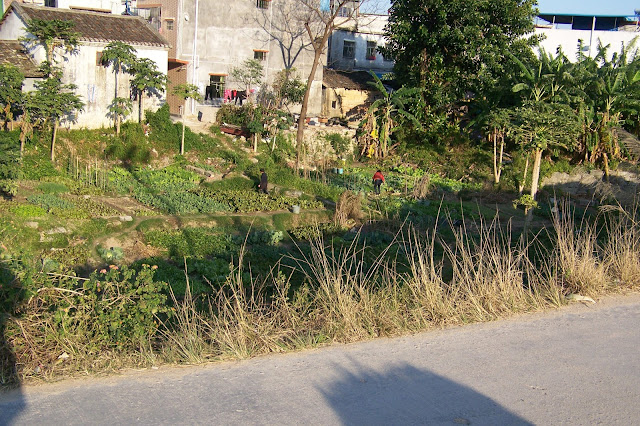Village End-notes
Note 5: The Hot Spring Bath
The last night we were in LuHe it was decided that we would go to the Hot Spring Bath Motel, a spa built over naturally occurring hot springs.
Some time after dinner, three noodle dishes and two vegetables I can't name, we headed out in two BMW's toward the Hot Springs. Edward's mother drove the lead car with her sister and brother-in-law, while Edward, with Yujia, Donna, and me in the other, gave chase.
I have written about these driving adventures before, noting mostly how we negotiated road hazards and the intricacies of full throttle dodge-em in daylight. This drive to the spa took place at night -- a very dark, moonless night. On roads without lights.
Edward worked hard to stay within sight of his mother, who not only handles the car with practiced skill but with Edward's skill for finding the third lane and split second decision making as well. She has, we might say, nerves made of something harder and more durable than steel. This was the same trip on which a passenger bus, the Chinese equivalent of a Greyhound, chased us for close to ten minutes, blasting its horn and flashing its lights, before shooting out around us on a corner.
One of the interesting aspects of night driving in China is that the cars have a special feature -- a kind of rapid, intense flashing of the headlights. These are warning strobes Americans see only on police cars and emergency vehicles. They are blinding. And I think they are used at night the way horns are used in daylight, as a signal to say, "I'm coming around, move over!"
I could be wrong, of course. It seemed like there were lots of cars flashing their lights when the pack got dense and simple jockeying didn't open a lane. Nearly everyone seemed to be using the flashers.
It was particularly jarring when lights started flashing from the car riding your bumper. They lit up the car's interior like an operating room. I wanted to ask Edward about them but thought it wise not to disrupt his concentration.
Forty-five minutes of this intense road racing later, we pulled in at the Hot Spring Bath Motel. We were all wound up tight from the ride, so the bath sounded promising.
The Hot Springs Bath Motel is laid out like any one story American motel, with an office at one end and then several long arms of side-by-side rooms. There were dim lights over the doors of the rooms, but no windows anywhere. Everyone but Donna and me
went into the motel office to make arrangements; we stood in the empty parking lot decompressing, trying to imagine what awaited us.
Soon the others emerged with the manager and an assistant carrying an armload of towels.We walked to the second arm of the motel, where the manager opened a solid metal door and handed us towels.
Edward turned to Donna and said, " Do you want a room of your own, Mom?"
Donna grabbed my arm and pushed me through the door ahead of her. "Not a chance!"
The room was a concrete box lit by a single dim florescent lamp near the door. Its walls were painted cinder block. There was a wooden bench near the door at the high end of the room. At the other end, down a gently sloping floor, was a stone jacuzzi big enough for five or six people. As instructed, we turned on the water that poured into the tub through a three inch pipe.
We folded our clothes on the bench, slipped on the rubber flip flops, and shuffled down the slope. The water was indeed hot. We stepped in rather carefully and gradually submerged ourselves. Once I was seated with hot water up to my shoulders, I noticed that the ceiling overhead was actually open to the night air, no doubt to keep the room from becoming a steam bath. Two or three feet above the opening was a pitched metal roof to keep rain out.
In no time, the hot water had done its magic: we were cooked inside and out and had to climb from the tub into our towels. Steam rising from our bodies looked quite spectacular in the pale florescent light.
When we came out maybe a half hour later, the parking lot was nearly filled with cars. Gradually everyone from our group reassembled and we drove to a restaurant to eat.
Perhaps the traffic was lighter on the way back. Perhaps the adrenaline rush of competitive driving had been soothed away by the hot waters. Clearly the high point of the evening had already been reached.
Whatever the reason, we drove back to LuHe much more sedately than we had driven out to the Motel. At least it seemed that way. Even the flashing strobes lighting up the car's interior did not disturb our sleepy contentment.

































